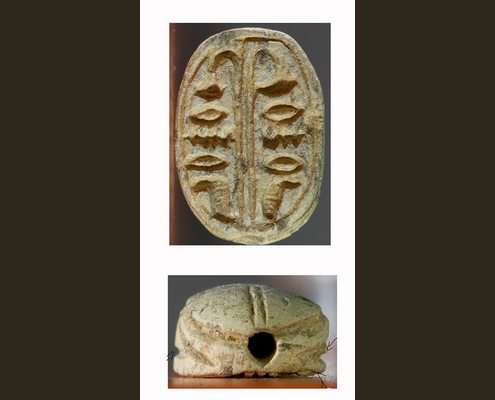Tag Archive for: Seal

Early Islamic Destruction Layer?
Artifacts from Early Islamic Period may be from 658 CE earthquake.

Archaeological Evidence of the Jewish Temples on the Temple Mount
Historical sources and selected artifacts given to show proof of the First and Second Jewish Temples on the Temple Mount. Jews and Christians have a real and documented relationship to the Temple Mount.
Tag Archive for: Seal

Soapstone Scarab (2nd Millennium BCE)
An soapstone (steatite) scarab with Egyptian hieroglyphs, 2nd millennium BCE. A perforated drill-hole allowed the scarab to be worn as an amulet or trinket.
Beetle-like scarabs are found throughout Canaan from the 20th century BCE onward,…

Lead Israeli(?) Kashrut Sealing, Post-1967
A modern Israeli lead bulla, post-1967, bearing a Hebrew inscription.
Side A: Kasher כשר
Side B: Two letters; probably the initials of the kashrut supervisor.
Note the bit of plastic on the side, a remnant of the food wrapper this seal was affixed to.

Lead Sealing of the Republic of Lebanon 1943
A lead bulla. The Arabic inscription, reading “The Republic of Lebanon”, postdate the artifact to 1943, the year of Lebanese independence.

Lead Sealing of the Vatican City State (1929–1999)
A lead bulla of the Vatican.
Obverse: Coat of Arms of the Vatican
Reverse: Verifica S.C.V — Authenticated by the City State of the Vatican.
The style of the bulla and its inscription point to a date in the 19th–20th centuries.

Bronze Seal of the Deputy-Mufti (18th Cent. CE)
An Ottoman bronze seal, from the early 18th century CE.
Inscription: الثيح \عبد \ الفتاح \ التميمي; ‛Abd al-Fatah al Tamimi The Sheikh.
‛Abd al-Fatah al Tamimi was a well known Muslim judge and legislator, serving as kadi in Nablus, Ramla and Gaza, and as deputy-Mufti in Jerusalem. This seal is one of several Ottoman seals of the 18th–20th centuries found by the project, many bearing given names and official titles

Seal Impression of the Winemakers of Rhodes (175-170 BCE)
An Amphora handle bearing the mark of winemakers of the Island of Rhodes, produced between 175-170 BCE. The Rose, symbol of Rhodes is evident in the center, surrounded by a Greek inscription naming the eponym — the clerk in charge during that year. The inscription on the seal impression reads: "Ἐπὶ Θεαιδ̣[ήτου Ὑ]ακινθίου" (Under [the year of the eponym] Theaidetos, [in the month of] Hyakinthios).

Clay Sealings of [Hi]ṩilyahu Son of Immer (7th Cent. BCE)
A Judean, late First Temple Period (7th century BCE), clay sealing bearing the name [Hi]ṩilyahu son of Immer. This artifact represents the most direct evidence ever uncovered of the administration of the First Temple. The clay sealing was affixed to a fabric cover of a container, and is reminiscent of many such sealings found in temple and palace treasuries throughout the Ancient Near East.
The Immer family, of which the owner of the seal was a proud member, operated in the First Temple, and one of its members is referred to in the Bible as “chief administrator in the house of the LORD” (Jer. 20:1). This sealing may have sealed a container of provisions for the Temple, or valuables kept in the Temple's treasury, overseen by priests of the Immer family.
This is the first Hebrew inscription originating in the Temple itself ever discovered, relating directly the the administrative duties overseen by the priests.

Handle Fragment of a Royal Storage Jar (8th Cent. BCE)
A handle fragment of a royal storage jar of the 8th century BCE. Prior to the firing of the jar, its handle was stamped with a seal, of which just the wingtip of a two-winged royal icon remains visible. Above the royal icon, word LMLK ("of the…

Conical Seal (11th-10th Cent. BCE)
A conical stone seal of the early First Temple Period (late 11th – early 10th century BCE), depicting a pair of animals, possibly a predator and its prey. Seals of similar type have been found in late Iron Age I – early Iron Age II sites throughout the country, Judean and Canaanite alike. This seal may attest to administrative activity at the Temple Mount as early as the beginning of the Iron Age II (the First Temple Period).

Soapstone Scarab Seal (13th Cent. BCE)
A soapstone (steatite) Egyptian scarab, of the 13th cent. BCE. Note the remnants of a bronze clasp. Pictured is an Egyptian deity (possibly Sekhmet) wielding a staff, beside hieroglyphs. This specific amulet was fastened onto a ring. This is one of many scarab amulets that have been found in the sifting, with various forms of Egyptian imagery and characters.


